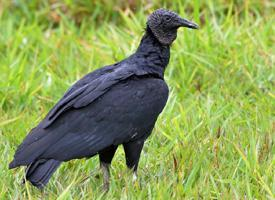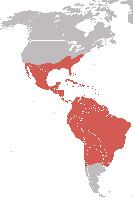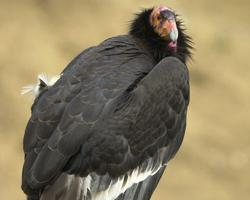
Poids et mesures
| Hauteur au garrot | de 58 à 68 cm |
|---|
Description de l'animal
The Black Vulture (Coragyps atratus), also known as the American Black Vulture, is a bird of prey in the New World vulture family, Cathartidae. This species is native to the Americas, ranging from the southeastern United States to Central Chile and Uruguay in South America. It is a scavenger and feeds almost exclusively on carrion. The Black Vulture is a large bird, with a wingspan of about 1.5 meters (4.9 feet), characterized by its bare black head, broad wings, and short tail.Physical Appearance:
The Black Vulture has a distinctive appearance. Adults have a uniform black coloration across their bodies, with the exception of the tips of their wings, which are silvery or white on the underside. The bird's head and neck are featherless and appear dark grey to black, with skin that is wrinkled and can appear almost rubbery. Its eyes are dark, and it has a hooked beak that is well adapted for tearing flesh. Juveniles are similar in appearance to adults but may have a more brownish hue to their plumage.
Behavior and Ecology:
Black Vultures are social creatures and are often seen in large groups. They roost in communal settings, sometimes in large numbers, and these roosts can be used for many years. Their flight is strong and direct, and they utilize thermals to soar gracefully in the sky as they search for food. Unlike their relative, the Turkey Vulture, which relies heavily on its sense of smell to locate carrion, Black Vultures are more dependent on their keen eyesight and often follow Turkey Vultures to food sources.
Diet:
As scavengers, Black Vultures play a critical role in their ecosystem by consuming dead animals, thus preventing the spread of diseases that could be transmitted by decaying carcasses. They feed on a variety of carrion, from large mammals to dead fish and insects. On rare occasions, they may kill weak or dying animals.
Reproduction:
Black Vultures are monogamous birds, with pairs forming strong bonds. They do not build traditional nests; instead, they lay their eggs in sheltered locations on the ground, such as in caves, hollow trees, or even abandoned buildings. Typically, a female lays 2 eggs, which are incubated by both parents for about 38 to 41 days. The chicks are altricial, meaning they are born helpless and require care from their parents. Both parents are involved in feeding and protecting the chicks until they fledge, which occurs around 2 to 3 months after hatching.
Conservation Status:
The Black Vulture is considered to be of Least Concern by the International Union for Conservation of Nature (IUCN) due to its wide range and large population, which appears to be stable or even increasing in some areas. However, they are not without threats; habitat destruction, poisoning (both intentional and unintentional), and collisions with vehicles and structures are among the challenges they face.
Despite their somewhat ominous appearance and association with death, Black Vultures are fascinating creatures that play an indispensable role in their ecosystems. Their social nature, intriguing behaviors, and adaptability make them a subject of interest not only for ornithologists but also for nature enthusiasts.
Carte de répartition

Animaux similaires
Nouvelles photos d'animaux
Top 10 des animaux
- Dolphin gull (Leucophaeus scoresbii)
- Japanese macaque (Macaca fuscata)
- Stone loach (Barbatula barbatula)
- Greek tortoise (Testudo graeca)
- Russian tortoise (Testudo horsfieldii)
- Galápagos tortoise (Geochelone nigra complex)
- Diana monkey (Cercopithecus diana)
- Moustached guenon (Cercopithecus cephus)
- Common flying dragon (Draco volans)
- Galápagos penguin (Spheniscus mendiculus)


